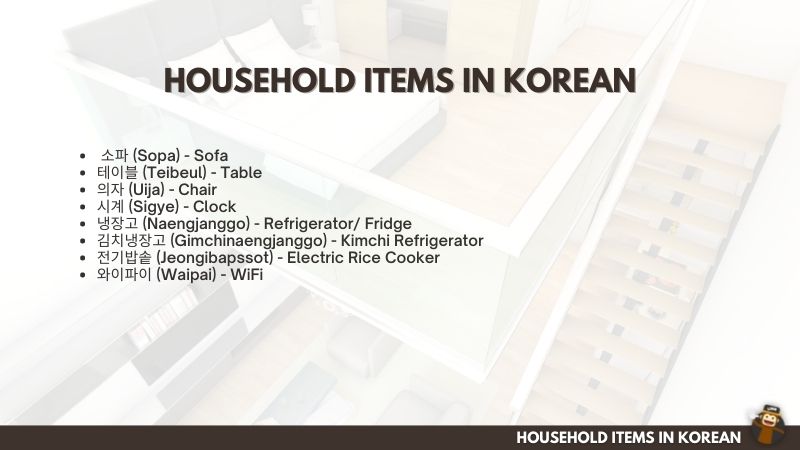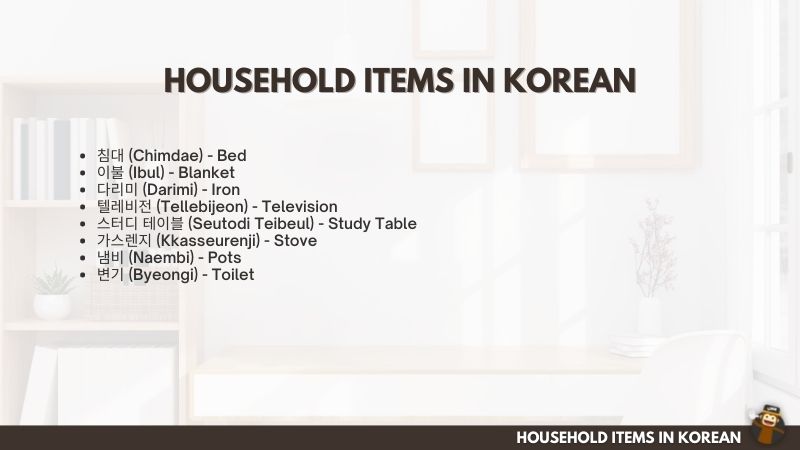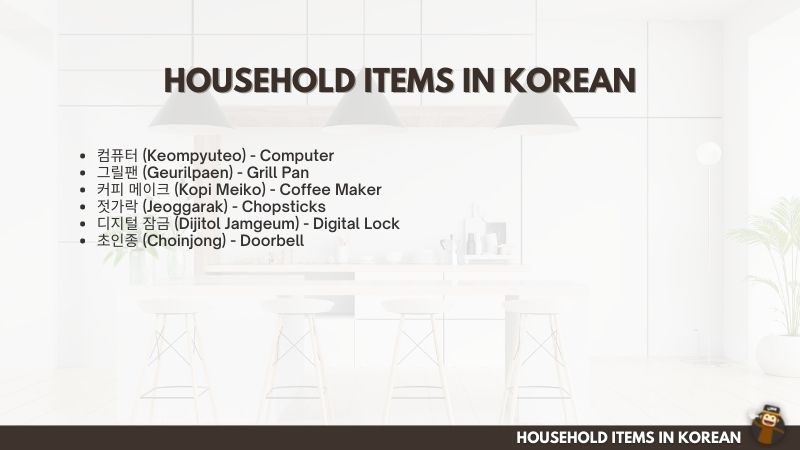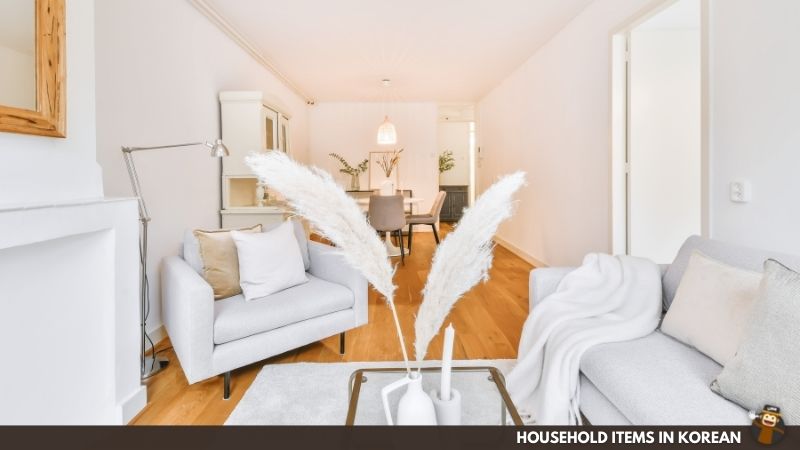When it comes to cool household items, Koreans are one of those on the top list. When you go to Korea, you may find yourself in a situation where you need to what you need. For that time, and even if it is not necessarily that time, please take a look at the contents below as a simple Korean common sense. So, let’s first learn some household items vocabulary in Korean.
Aside from K-pop songs, K-dramas and Mukbangs, the other most-viewed Korean contents are the house/apartment tours. Koreans have a lot of cool and aesthetically pleasing household items that are used in daily life. What’s more interesting is that you can score good deals in a Korean supermarket.
Knowing this basic household items vocabulary in Korean will go a long way. First, since you’re staying in accommodation, it will help you navigate things inside the room or house. Second, you can also use this vocabulary in almost every situation like asking for a household item, repairing, or even buying one. Of course, it will also widen your Korean vocabulary.
So, do not miss this opportunity to learn some basic household items vocabulary in Korean. This will definitely make your life much easier.
Basic Household Items Vocabulary In Korean
When we talk about household items, there are standard things that we usually see inside the house, whether in Korea or not. So, let’s learn the Korean words for these household items.

소파 (Sopa) – Sofa
나는 TV를 보면서 소파에 앉는다. (naneun tibeuireul bomyonso sopae anneunda) – I sit on the sofa while watching TV.
The living room is usually the first room you’ll see when you enter a typical house. Of course, the most important household item in a living room is a sofa (소파 sopa). This is where families gather to watch television, eat snacks, have a family meeting, and more. It is also where guests sit when they visit.
Nowadays, sofabeds (소파 침대 sopa chimdae) are in-demand because it’s a space-save and a budget-saver as well because they can serve both as sofas and a bed.
테이블 (Teibeul) – Table
식탁을 정돈하다 (siktageul jongdonhada) – Put the table in order.
Tables (테이블 teibeul) are very important in a Korean household. As seen in K-dramas, they sometimes don’t have any chairs because they usually sit on the floor, but they have tables most of the time.
In Korean movies, we usually see two kinds of tables. First is the dining table, which is the big one used when Korean families eat breakfast, lunch, or dinner. The second is the smaller one, which is usually used in snacks or drinks. But, some families do not have space for a big table, so they use the smaller one and sit on the floor.
의자 (Uija) – Chair
의자를 정돈하다 (uijareul jongdonhada) – Arrange the chair.
Chairs (의자 uija) in Korea are pretty interesting to talk about. Have you noticed that they are used to sitting on the floor? This practice was believed to promote a quiet and pleasant state of mind and foster a sense of belonging. However, “floor culture” has given way to tables and chairs as many Koreans choose to eat while sitting in chairs rather than on the floor.
시계 (Sigye) – Clock
지금 당신은 시계에 있습니다. (jigeum dangsineun sigyee itsseumnida) – The clock is ticking.
Koreans are known for their pali-pali culture, where everything is organized and fast-moving. So, clocks (시계 sigye) are essential in a Korean household.
냉장고 (Naengjanggo) – Refrigerator/Fridge
우리가 냉장고를 사용해도 될까요? (uriga naengjanggoreul sayonghaedo dwelkkayo) – Can we use the refrigerator?
Having a fridge (냉장고 Naengjanggo) is really important in a Korean household. They have lots of different side dishes in a meal so`= it’s better to keep stocks of food in the fridge.
김치냉장고 (Gimchinaengjanggo) – Kimchi Refrigerator
김치를 김치 냉장고에 가지고 오세요. (gimchireul gimchi naengjanggoe gajigo oseyo) – Bring the kimchi to the kimchi refrigerator.
It’s no secret that Koreans love Kimchi, so it’s not surprising that they have a specific refrigerator for their Kimchi. They eat almost everything with Kimchi, so it’s reasonable to store it properly.
전기밥솥 (Jeongibapssot) – Electric Rice Cooker
나는 새 전기밥솥을 샀다. (naneun sae jongibapssoteul sattta) – I bought a new electric rice cooker.
Remember the scene in Crash Landing On You where North Koreans are not allowed to have an electric rice cooker from South Korea? Well, this electric rice cooker is quite different from the common one, so it’s hard not to want to buy this kind of electric rice cooker seen on K-dramas.
와이파이 (Waipai) – WiFi
와이파이 있어요? (waipai issoyo) – Do you have wifi?
Today, it’s impossible not to find a house without wifi. The speed in South Korea is four times quicker than the global average of 7.0 Mbit/s. According to Akamai Technologies’ State of the Internet report, South Korea had the fastest average internet connection in the world in 2017 at 28.6 Mbit/s.

침대 (Chimdae) – Bed
침대를 고치다. (chimdaereul gochida) – Fix the bed.
Beds (침대 Chimdae) in Korea are also interesting to talk about. There are different kinds of beds that Koreans use. You can see it in their K-dramas. Some use beds with bedframes, while some just sleep on the floor with a mattress.
이불 (Ibul) – Blanket
두꺼운 담요를 사세요. (dukkoun damnyoreul saseyo) – Buy a thick blanket.
South Korea’s climate can be too cold, especially during the winter season. So, blankets (이불 ibul) are really needed in a household. They even use double blankets and heaters to stay warm.
다리미 (Darimi) – Iron
다리미가 있습니까? (darimiga itsseumnikka) – Do you have an iron?
Koreans are well-dressed and groomed, especially in school or work; that’s why having iron (다리미 Darimi) in every household is a must. There’s a scene in Reply 1988 where Jung Hwan’s parents argue because of a broken iron. That’s how important iron is in a Korean household.
텔레비전 (Tellebijeon) – Television
텔레비전에서 한국 드라마를 보자. (telrebijoneso hanguk deuramareul boja) – Let’s watch Korean dramas on TV.
Televisions (텔레비전 tellebijeon) for Koreans are a source of entertainment and a way for family and friends to gather together. Even in this age where everything is on the internet, televisions are still in-demand in Korea, especially because K-dramas are being shown.
스터디 테이블 (Seutodi Teibeul) – Study Table
나는 공부 테이블에서 공부한다. (naneun gongbu teibeureso gongbuhanda) – I study at my study table.
Another household item that most Korean homes have is the study table (스터디 테이블 Seutodi Teibeul). You know how Koreans value education, right? So they make sure that there is an intended study space in their home.
Remember Na Hee-do and Sung Deok-sun’s study table, right? Those are the perfect example of what a Korean study table looks like. Sometimes, Korean girls also use this table as their vanity table where they put their skincare and cosmetic products.
가스렌지 (Gasseurenji) – Stove
가스레인지가 작동이 안 돼요. (kkasseureinjiga jakttongi an dwaeyo) – The gas stove is not working.
When it comes to food, Korean cuisine is one of the best, so having a stove (스렌지 gasseurenji) is really important. If you have watched the K-drama Reply 1988, there are lots of different stoves used by Koreans; there are electric stoves, portable stoves, gas stoves, and more.
냄비 (Naembi) – Pots
라면을 냄비에 넣으세요. (ramyoneul naembie noeuseyo) – Put the ramen in the pot.
Instant ramen is must-have food in a Korean house. So, make sure that you have the perfect household items for that, the silver-nickel pots. You can also use this in cooking stews and soups.
세탁기 (Setakggi) – Washing Machine
세탁기 사용법은? (setakkki sayongppobeun) – How to use the washing machine?
K-dramas like Crash Landing On You, Reply 1988, and Boys Over Flower give us a glance at how Koreans do their laundry, but of course, in this modern era, washing machines are commonly found in a household. Since South Korea is home to large technology companies, it’s no surprise that they have the latest advancements like the Korean washing machines. You can check those blogs out to have an overview of how to use a Korean washing machine.

변기 (Byeongi) – Toilet
화장실이 어디에 있나요? (Hwajangsiri eodie innayo?) – Where is the toilet?
The toilet is a standard item that every household should have. You can see a variety of toilets in Korea, starting from the most modern, like the one with a keypad, down to the traditional one like the squatter toilets, which is technically porcelain hole in the floor.
컴퓨터 (Keompyuteo) – Computer
컴퓨터는 유용하다. (Kompyutoneun yuyonghada) – Computers are helpful.
Have you watched the K-drama Start-up? That will give you an idea of how important computers are in South Korea. In K-dramas, you’ll see that there is at least one computer in a household. Desktops computers are quite expensive, so some resort to buying laptops (노트북 nothbuk).
According to the Korea Advanced Institute of Science and Technology, South Korean researchers have invented a computer that can preserve data long after the power is turned off, facilitating approaches to cut electric power use.
그릴 팬 (Geuril paen) – Grill Pan
그릴 팬을 꺼내세요. geuril paeneul kkonaeseyo – Bring out the grill pan.
Every hour is a pork belly hour, and to cook it, you’ll need a grill pan. In Korea, if they crave pork belly (Samgyupsal), they don’t need to go to the nearest restaurant because they usually have a portable or electric grill pan (그릴팬 geurilpaen) at their home. Korean families and friends enjoy shared grilled meals, so a grilling pan is a no-brainer household item.
커피 메이커 (Kopi Meikor) – Coffee Maker
나는 커피 메이커로 커피를 만들었다. naneun kopi meikoro kopireul mandeurottta – I made coffee with a coffee maker.
Coffee makers are especially trendy nowadays. Even in K-dramas, you’ll see different kinds of coffee makers used by the Koreans. Upon seeing these items, you’ll sure wanna buy your own. So, if you wanna recreate a K-drama scene with a coffee maker, then buy your own now!
젓가락 (Jeoggarak) – Chopsticks
저는 젓가락을 사용할 줄 몰라요. (joneun jotkkarageul sayonghal jjul molrayo) – I don’t know how to use chopsticks.
Chopsticks (젓가락 Jeoggarak) – are one of the primary utensils used by Koreans in dining, so there’s no need to explain further about this one. You can check this video out if you don’t know how to use chopsticks.
디지털 잠금 (Dijitol Jamgeum) – Digital Lock
Digital locks (디지털 잠금 dijitol jamgeum) are extremely popular in South Korea. It adds extra safety compared to the common locks. It’s a lot more expensive compared to the common ones, but you don’t put a price on safety, especially nowadays.
초인종 (Choinjong) – Doorbell
초인종을 누르세요. (choinjongeul nureuseyo) – Ring the doorbell.
Doorbells are also popular in South Korea, especially the ones with a built-in camera already. Aside from you can talk to the person at the door, you can also see them, which makes you safer.
Other Household Items Vocabulary In Korean

Let us start with the general household items. These items can be found in the living room, bedroom, and other parts of the house. They are typically furniture or items used for repairing and improving the overall ambiance and look of the house.
After the general household items, let’s move to the kitchen and bathroom excluding the appliances. I’m pretty sure that you have watched a lot of K-dramas that feature cooking dishes and doing skincare. With that, it’s important to know some basic household utensils used in the kitchen and bathroom. These household items help us go around the kitchen easily and maintain our hygiene.
| Korean | Romanization | English Translation | Pronunciation |
| 병따개 | byeongttagae | bottle opener | |
| 그릇 | geureut | bowl | |
| 젓가락 | jeoggarak | chopsticks | |
| 조리 기구 | chhori khigu | cooking utensils | |
| 식기세척기 | sikgisecheokgi | dishwasher | |
| 밥 그릇 | bap geureut | rice bowl | |
| 비누 | phinu | soap | |
| 스펀지 | seupeonji | sponge | |
| 숟가락, 스푼 | sutkkarak, seupun | spoon, spoons | |
| 국 그릇 | guk geureut | soup bowl | |
| 수세미 | susemi | scrubbing sponge | |
| 스킨케어 제품 | seukinkeo jepum | skincare products | |
| 주전자 | jujeonja | teapot | |
| 휴지 | hyuji | toilet paper | |
| 칫솔 | chissol | toothbrush | |
| 치약 | chiyak | toothpaste |
When it comes to trendy appliances, South Korea does not disappoint us. These household items make our daily lives easier thanks to the development of technology. Today, almost everything can be done with a click because of these appliances.
Do You Know Any Household Item For Learning Korean Language?
Learning Korean can also be done at home. No need to go to a Korean school like Seoul National University just to learn Korean because there’s actually a platform that you can use at home. This platform is no other than Ling App.
With Ling App, you can develop your language skills. Actual native speakers develop the lessons, so you won’t be worrying about the accuracy. There are dialogues that can help you develop your speaking skills. Even the main accent of Koreans will be achievable if you just put effort into learning.

Signing up is easy. You can just simply click this link, and you’ll be directed to a new tab. Find the signup button and make sure that there’s no required field missing. You can also use your existing email address. Invalid email addresses won’t work, so make sure that you’ll enter a valid one. After creating your account, you can start learning Korean online. It can be through the website or download the app.
So, spend your free time at home learning Korean. Start your first lesson with Ling App now!



































































